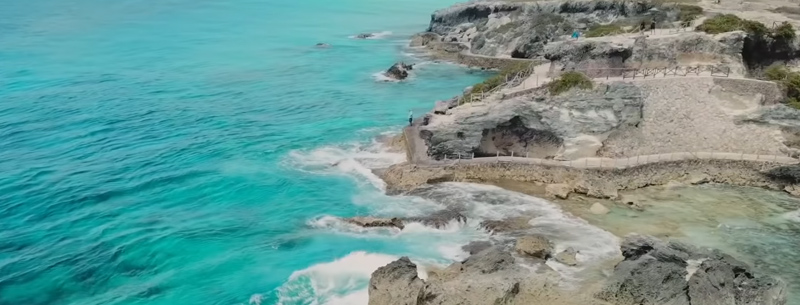Isla Mujeres: Cancun’s most popular daytrip
Enchanting might be the best single word to describe Isla Mujeres, a tiny jewel of an island just off the coast of Cancun, Mexico. Isolated from the flashing lights and fancy hotels on the nearby Quintana Roo mainland, this secluded destination offers the best of many worlds, from ancient and historical to modern and high-tech.
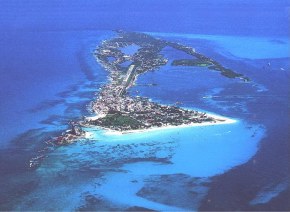 Isla Mujeres in Mexico is a great way to escape the tourist crush in Cancun. Roughly 9 miles offshore, the island contains the Mexican beach culture of a bygone era. Oh, and the name translates to “The Island of Women.” It’s a short ferry ride away from the biggest tourist destination in Mexico, yet has maintained its charm from back when it was just a fishing village. Those who are in the know will spend more than just a day there. And if you are looking for the best boutique hotel with the best food on the island, then look no further than the amazing Zoëtry Villa Rolandi.
Isla Mujeres in Mexico is a great way to escape the tourist crush in Cancun. Roughly 9 miles offshore, the island contains the Mexican beach culture of a bygone era. Oh, and the name translates to “The Island of Women.” It’s a short ferry ride away from the biggest tourist destination in Mexico, yet has maintained its charm from back when it was just a fishing village. Those who are in the know will spend more than just a day there. And if you are looking for the best boutique hotel with the best food on the island, then look no further than the amazing Zoëtry Villa Rolandi.
Island of Women Mexico
Just six miles from Cancun, yet a world apart, Isla Mujeres is a needlefish-shaped island (5 miles long and a quarter mile wide at its widest point) offering relaxed village life. It is Mexico’s easternmost bit of land—the sun shines here first, rising over the Caribbean then, all too soon, setting over the Yucatan mainland.
Unlike its young neighbor, Cancun, “Isla,” as it is often called, has centuries of history and generations of native inhabitants. This island still retains its manifold blend of traditions: Mayan, Yucatecan, Caribbean, and Spanish. Here, a warm feeling of pueblo and community pride mingles with an enduring air of serenity.
First things first, the Island of Women is not populated with more, different, or any other classification of women than you would normally find in Mexico. Okay, there is a Bay of Women, but don’t go there. Instead, Isla Mujeres is simply a stunningly beautiful island. It’s absolutely one of the best beaches and the best experiences we’ve had in Mexico. Some of the prettiest and cleanest water we’ve ever seen without (sin) the smelly problematic seaweed called Sargassum ( Sargazo) and we literally got to SWIM with the fish.
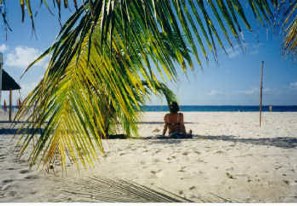 At five miles long and less than a half-mile wide, the island has long been a significant figure in regional history in spite of its small size. For one, it is perfectly situated between the Caribbean and the Gulf, once the perfect place to loot Spanish and French ships laden with treasures.
At five miles long and less than a half-mile wide, the island has long been a significant figure in regional history in spite of its small size. For one, it is perfectly situated between the Caribbean and the Gulf, once the perfect place to loot Spanish and French ships laden with treasures.
According to the State of Quintana Roo’s Web site, Isla Mujeres has a long and colorful history. In Mayan times the island served as the sanctuary for the goddess Ixchel, the Goddess of fertility, reason, medicine, and the moon. The Temple was located at the South point of the island and was also used as a lighthouse. The light from torches filtered through holes in the walls, which could be seen by navigators at sea. The Mayans also came to the island to harvest salt from the salt lagoons.
El Garrafón National Park
El Garrafón National Park is, of course, one of the best places to snorkel and play in the water. Located on the Southwest end of the island, you won’t find better reef and tropical fish action that you can reach without a boat.
 Speaking of boats, there are plenty for hire on the island. The sea-worthy Mayan boatmen are experienced in these usually calm waters and know the best places to snorkel, fish, and sight-see.
Speaking of boats, there are plenty for hire on the island. The sea-worthy Mayan boatmen are experienced in these usually calm waters and know the best places to snorkel, fish, and sight-see.
If you’re a diver, the famed Cave of the Sleeping Sharks is just off the east shoreline a few miles. There is a pirate shipwreck to dive into, as well as great reef action all around the island. Isla Contoy, a 30-minute boat ride away, is a Mexican national wildlife refuge. You can take a tour with a dozen or more local companies that provide the service. You get to fish on the way and the crew will cook your catch while you explore the island. The Survivor TV series would do well to discover this great hideout.
If you’re into archeology or have an interest in the ancient past, there’s plenty to see all across the Yucatan peninsula. Tulum stands guard on the cliffs overlooking the Caribbean and is close enough to take a tour bus or rental car out of Cancun. Rent the car (Jeep) and go early before the buses arrive!
Chichen Itza, a couple of hours away, is a major site that shouldn’t be missed, and nearby Merida is an ancient Maya center of culture that deserves a visit. And there are other commercial sites, like Xcaret and Xel-Ha, both of which are commercialized visitor havens, but interesting enough to consider visiting if you have the time. More like theme parks, the sites do offer the type of service and amenities many U. S. travelers require.
Snorkeling and Diving
El Garrafon National Underwater Park is located on the southwest end of the Island. If you’re interested in underwater fun, this park provides tremendous visibility in warm water. Unfortunately, a private company now runs the park. This, of course, means you have to pay to enter and the tranquil area has a definite touristy feel with kayaks and other water toys for rent. Still, the park is very large and your experience shouldn’t be overly impacted.
If you’re looking for more of a beach town feel, the northern tip of the island should be your destination. Playa Norte’ offers nice beaches, restaurants, hotels, and more or less everything you could need. Head out on Zacil Ha road and you can find some fairly isolated beaches.
If total isolation is your thing, there are plenty of remote beach areas on the island. Walk south from Playa Pescador and you’ll leave humanity behind. The same is true if you head north from Playa Lancheros. Just grab a map of the island or ask a local for directions.
Lodging and Dining
You certainly have a lot of choices here. You can opt for a room at a small Hotel for as little as $35-$45 a night, move up to a nicer hotel or lodge for less than $100, or choose a villa or condo for a little more or a resort lodge for $130 and up. Hotel Cabanas, Maria del Mar, was one of my favorite resting places, with off-season rates of around $70 a night.
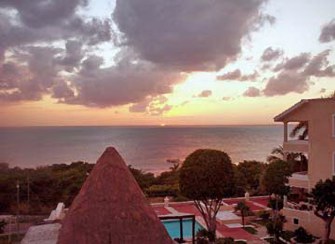 As far as dining is concerned, the days of the $6 lobster are gone I’m afraid. But Caribbean lobster is delicious and worth the $20-$30 you pay for it. Fresh ceviche is available almost everywhere on the island, though I would recommend Las Brisas’ palapa bar near the ferry docks. You can live on it, you know!
As far as dining is concerned, the days of the $6 lobster are gone I’m afraid. But Caribbean lobster is delicious and worth the $20-$30 you pay for it. Fresh ceviche is available almost everywhere on the island, though I would recommend Las Brisas’ palapa bar near the ferry docks. You can live on it, you know!
The seafood here, as you might expect, is excellent and quite reasonably priced. In town, Pizza Rolandi offers good Italian food and a pleasant ambiance. Exquisite cuisine in a setting of beachside simplicity is served graciously at Zazil-Ha, the restaurant at the Na-Balam hotel. Chez Magaly offers low-key beachside dining at the Nautibeach hotel/condo complex; there’s also a small palm-thatched bar.
Otherwise, there are countless places to eat, most are good, a few terrible, and some are just great. Rolandi’s Pizza in the heart of the village is another of my favorites – good pizza, cold drinks, and big screen TVs, a great place to catch up with the Weather Channel, which – by the way – is on most of the summer months.
Water Sports
The best beach, an expansive stretch of sand at the northernmost lee side, is Playa Norte (also known as Playa Los Cocos ). The water is shallow and as calm and clear as a swimming pool, and the soft porous limestone sand never gets hot. Here, jet skis, windsurf boards, aqua-tricycles, banana boats, and other water gadgets are available from Tarzan’s Water Sports on the beach (ask for Tarzan, of course).
With its coral gardens, reefs, and lagoon, Isla Mujeres is an attractive base for snorkeling and diving—so much so that an island visit is included in most seafaring tours out of Cancun. Most of these day trips include newly-renovated El Garrafon National Park, a shallow coral reef just off the island’s southwest shore that’s good for swimming and snorkeling. There are dozens of varieties of brightly colored fish, and cannons and anchors from sunken Spanish galleons have been placed on the bottom to add to the scenery. Get to Garrafon either early or late in the day to avoid the “rush hours” when swimmers outnumber the fish.
About one kilometer off the southern tip of the island, Los Manchones (so called because from the surface there appear to be dark stains or manchones) is a series of beautiful coral reefs only 30 to 50 feet deep. Scuba divers find this one of the area’s main attractions.
Fascinating for experienced scuba divers is the Cave of the Sleeping Sharks, 60 feet deep in the open Caribbean northeast of the island. This bizarre phenomenon of immobile sharks (they must be in constant motion in order to breathe) was discovered by a local diver-fisherman who happened into the cave.
South of Macax Lagoon, on the lee side beach, is the marine biology station and turtle farm, Tortugranja. About 40,000 baby turtles are set free annually, and resident marine biologists offer interesting talks on the endangered species in several languages (small admission fee).
About a kilometer farther south, opposite the entrance to Hacienda Mundaca, is Playa Lancheros, where locals and tourists enjoy the pleasant beach, listen to recorded and live music, shop at little handicraft stalls, and eat lunch at the open-air restaurant.
On Isla you can also swim with dolphins, or simply have an up-close and personal encounter with them. Dolphin Discovery, which operates three such facilities in the Mexican Caribbean, lets visitors swim with the gentle, curious creatures, or join a petting session immersed waist-deep in one of the pens.
For boat trips—diving, snorkeling, fishing, sightseeing—Mexico Divers, La Bahia, and Coral Dive Center offer group and private excursions with expert guides, instructors, and rentals of the full gamut of snorkeling and scuba gear.
Nightlife
Nightlife is sparse compared to Cancun, but lively in its own way. The town square is a congregating point in the evenings. Na-Balam hotel’s beach bar draws a congenial clientele, and La Palapa, on Playa Norte, and El Penguino (slang for “cold beer”), a restaurant-bar annex to the Posada del Mar hotel, convert from daytime restaurants into nightspots.
Legend of Mundaca the Pirate
Fermin Antonio Mundaca y Marecheaga was born in October of the year 1825 in the village of Bermeo of Santa Maria, Spain. After completing his studies he set out for the New World to make his fortune. He arrived on the shores of Isla in 1858 after acquiring his wealth by selling captured Mayan slaves to Cuban plantations and, some say, pirating. Whether or not this is true, no one knows for certain, but Mundaca apparently cultivated and enjoyed his reputation as a pirate.
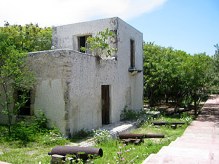 Mundaca immediately set out building a large hacienda he named “Vista Alegre” (Happy View) which eventually covered over 40% of the island. There were areas for livestock, birds, vegetable gardens, fruit orchards, and exotic plants that were brought from all over the world. A special garden called “The Rose of the Winds” was constructed which served as a sundial telling the time of the day by its shadows.
Mundaca immediately set out building a large hacienda he named “Vista Alegre” (Happy View) which eventually covered over 40% of the island. There were areas for livestock, birds, vegetable gardens, fruit orchards, and exotic plants that were brought from all over the world. A special garden called “The Rose of the Winds” was constructed which served as a sundial telling the time of the day by its shadows.
In 1862 Martiniana (Prisca) Gomez Pantoja was born. She was one of five sisters and it is been said that she was a willowy woman with green eyes, white skin bronzed by the Caribbean sun and long, straight hair. Called “La Triguena” (the brunette), many men fell in love with her including Mundaca. The arches above the gates were dedicated to her, naming them “The Entrance of the Triguena” and “The Pass of the Triguena” in hopes his wealth and power would win the local beauty 37 years younger than himself. His dedication was in vain, she married a man closer to her own age and as legend tells it, Fermin Mundaca slowly went insane and died. His empty tomb still awaits him in the Isla Mujeres cemetery. Carved by his own hands are the skull and cross bones, in memory of his pirating days and these words, “As you are, I was. As I am, you will be”.
Getting There
Catch a flight to Cancun, and take a taxi to Puerto Juárez. The are two Ferry docks to Isla Mujeres. Puerto Juárez & Gran Puerto Cancun which is 15 minutes north of downtown Cancun. Express boats leave every half hour and the crossing takes about 15 minutes and the fare is 35 pesos. The first crossing from Cancun is at 6:30 AM. Then beginning at 9:00 AM the express boats leave every hour until 12 midnight. From Isla Mujeres to Puerto Juárez, the ferries run every 30 minutes from 6:00 AM to 8:00 PM and last one out at 9:00 PM.
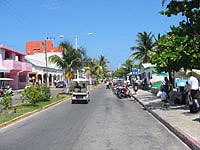 Isla Mujeres has an airport, but traveling by boat from Cancun is cheaper. There are numerous public ferries traveling to the island. Getting back and forth is no problem. Just make sure you check the schedule for return trips.
Isla Mujeres has an airport, but traveling by boat from Cancun is cheaper. There are numerous public ferries traveling to the island. Getting back and forth is no problem. Just make sure you check the schedule for return trips.
If you’re arriving by car or have a rental, there is a car ferry from Punta Sam (another 10 minutes down the road from Puerto Juarez). The ferry runs from 8am till about 8pm.
The currency in Mexico is the Peso. There are $20.00, $50.00, $100.00, $200.00 and $500.00 peso bills. The coins are $.10, $.20, $.50 centavos and $1.00 , $2.00, $5.00, $10.00 and $20.00 pesos. US dollars are accepted everywhere, even the small neighborhood stores. We suggest you wait until you arrive on Isla before you exchange any travelers checks or cash. Be sure to bring plenty of $1 dollar bills for tipping!
